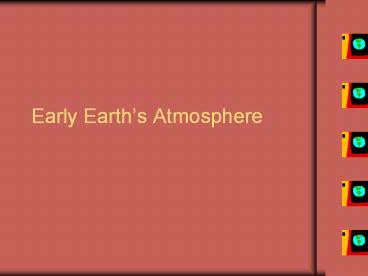Early Earth - PowerPoint PPT Presentation
Title: Early Earth
1
Early Earths Atmosphere
2
The First Atmosphere
- The early (first) atmosphere would have been
similar to the Sun--mainly hydrogen and helium,
but this atmosphere was lost quickly for two
reasons - (1) The gravity of the modest size earth was not
strong enough to prevent such light gases from
escaping to space. - (2) It appears that around 30 million years
after the earths formation, it was struck by a
large objectthe size of Mars. The result the
origin of the moon and loss of earths early H,
He atmosphere.
3
A Very Hot Earth
- The surface of the earth during this period was
extremely hot with numerous volcanoes - The earth was under near constant bombardment by
objects of varying sizes - Slowly, the earth started to cool down and the
second atmosphere began to form.
4
Earths Second Atmosphere
- A new atmosphere was established by the outgasing
of volcanoesthe mixture of gases was probably
similar to those of todays - H20 vapor (roughly 80)
- CO2 (roughly 10)
- N2 (few percent)
5
Earths Second Atmosphere
- Virtually no oxygen in that second atmosphere.
- Thus, no ozone layer, so ultraviolet radiation
flooded the earths surface. - With a huge influx of water vapor and the cooling
of the planet, clouds and earths oceans formed. - At that time the sun was about 30 weaker than
todaywhy didnt the earth freeze over? - The apparent reason so much CO2 so there was a
very strong greenhouse effect.
6
The Rise of Oxygen and the Third Atmosphere
- In the first two billion years of the planets
evolution, the atmosphere acquired a small amount
of oxygen, probably by the splitting of water
(H20) molecules by solar radiation. - The evidence of this oxygen is suggested by rust
in some early rocks. - The oxygen also led to the establishment of an
ozone layer that reduced UV radiation at the
surface. - With the rise of photosynthetic bacteria
(cyanobacteria) and early plants, oxygen levels
began to rise. - Between 2.5 billion years ago to about 500 mya,
02 rose to near current levels.
7
The Third Atmosphere
- While O2 was increasing, CO2 decreased due to
several reasons - (1) In photosynthesis, CO2 is used to produce
organic matter, some of which is lost to the
system (e.g., drops to the bottom of the ocean or
is buried) - (2) chemical weathering, which removes CO2
8
Chemical Weathering
- H20 CO2 --gt H2CO3 carbonic acid
- CaSiO3 H2CO3 --gt CaCO3 SiO2 H20
- Silicate Rock Carbonate
- At first this happened without life, but the
process was sped up tremendously by living
organisms - Marine organisms would incorporate carbonate into
their shells, which would fall to the ocean
bottom when they died---thus, removing them from
the system for a long time. - The bottom lineCO2 was being removed from the
system.
9
More Changes
- Sulfur compounds were taken out of the atmosphere
as acid rain and were deposited on the ground as
sulfates. - N2 gas increased slowly but progressively since
it was relatively inert. - Current composition of the atmosphere was
established approximately a billion years ago.
10
A Problem
- With lower CO2 levels, the earth became more
susceptible to ice ages when solar radiation
decreased due to orbital variations, - It appears that around 750-550 million years ago
the cooled down and became nearly entirely
glaciated.
11
How Did We Get UnFrozen?
- Volcanoes were still putting CO2 into the
atmosphere - Weathering was greatly reducedsince little
liquid water. - So CO2 increased until the greenhouse effect was
so large the earth warmed up. - Once warming started it would have happened very
rapidly.

